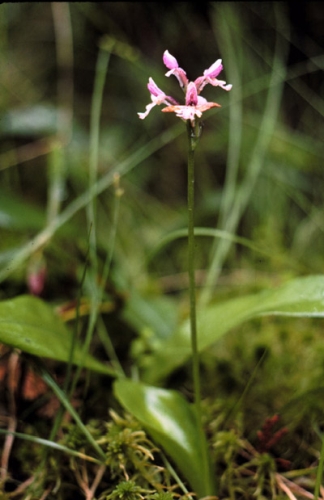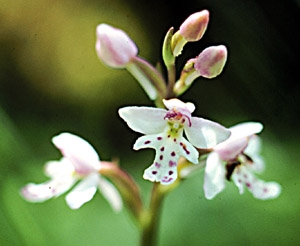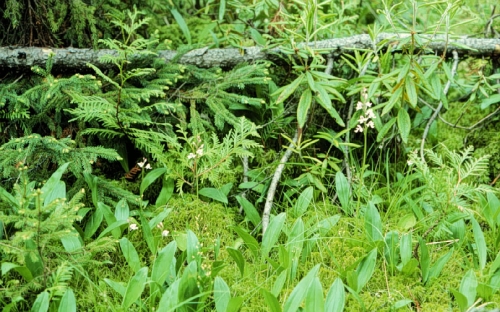Plants and Animals
Galearis rotundifolia Small round-leaved orchis
Key Characteristics
Small circumboreal orchid (10-25 cm) of cedar swamps bearing a single oval, basal leaf; flowers pale pink to white on a single tall stalk, with lower lip spotted with dark purple.
Status and Rank
US Status: No Status/Not Listed
State Status: E - Endangered (legally protected)
Global Rank: G5 - Secure
State Rank: S1 - Critically imperiled
Occurrences
| County | Number of Occurrences | Year Last Observed |
|---|---|---|
| Chippewa | 1 | 2013 |
| Delta | 1 | 2015 |
| Dickinson | 1 | 1883 |
| Emmet | 2 | 1981 |
| Keweenaw | 2 | 1981 |
| Marquette | 1 | 1891 |
| Menominee | 1 | 1968 |
| Oscoda | 1 | 1990 |
| Schoolcraft | 3 | 2015 |
Information is summarized from MNFI's database of rare species and community occurrences. Data may not reflect true distribution since much of the state has not been thoroughly surveyed.
Habitat
Found in cold northern swamps, semi-open fens, and large peatland complexes.
Natural Community Types
For each species, lists of natural communities were derived from review of the nearly 6,500 element occurrences in the MNFI database, in addition to herbarium label data for some taxa. In most cases, at least one specimen record exists for each listed natural community. For certain taxa, especially poorly collected or extirpated species of prairie and savanna habitats, natural community lists were derived from inferences from collection sites and habitat preferences in immediately adjacent states (particularly Indiana and Illinois). Natural communities are not listed for those species documented only from altered or ruderal habitats in Michigan, especially for taxa that occur in a variety of habitats outside of the state.
Natural communities are not listed in order of frequency of occurrence, but are rather derived from the full set of natural communities, organized by Ecological Group. In many cases, the general habitat descriptions should provide greater clarity and direction to the surveyor. In future versions of the Rare Species Explorer, we hope to incorporate natural community fidelity ranks for each taxon.
Associated Plants
Sphagnum moss, sedges, leatherleaf, bog rosemary, wild calla, round leaved sundew, cotton grass, swamp-laurel, large cranberry, small cranberry, three-leaved false Solomon's seal, yellow lady's slipper, showy lady's slipper, Labrador tea, heart-leaved twayblade, and blunt-leaf orchid, marsh fern, pitcher-plant, bog birch, northern white cedar, black spruce, and balsam fir.
Management Recommendations
Requires protection of habitat. This includes the maintenance of the overstory and ensuring a continuous cool groundwater supply to maintain microsite conditions.
Survey Methods
Random meander search covers areas that appear likely to have rare taxa, based on habitat and the judgement of the investigator.
-
Meander search
-
Survey Period: From first week of June to second week of July
-
References
Survey References
- Elzinga, C.L., D.W. Salzer, and J.W. Willoughby. 1998. Measuring and Monitoring Plant Populations. The Nature Conservancy and Bureau of Land Management, Denver. BLM Technical Reference 1730-1. 477pp.
- Goff, G.F., G.A. Dawson, and J.J. Rochow. 1982. Site examination for Threatened and Endangered plant species. Environmental Management 6(4): 307-316
- Nelson, J.R. 1984. Rare Plant Field Survey Guidelines. In: J.P. Smith and R. York. Inventory of rare and endangered vascular plants of California. 3rd Ed. California Native Plant Society, Berkeley. 174pp.
- Nelson, J.R. 1986. Rare Plant Surveys: Techniques For Impact Assessment. Natural Areas Journal 5(3):18-30.
- Nelson, J.R. 1987. Rare Plant Surveys: Techniques for Impact Assessment. In: Conservation and management of rare and endangered plants. Ed. T.S. Elias. California Native Plant Society, Sacramento. 8pp.
Technical References
- Argus, G.W. and K.M. Pryer. 1990. Rare vascular plants in Canada: our natural heritage. Canadian Museum of Nature, Ottawa, Canada. 191pp.
- Case, F.W., Jr. 1987. Orchids of the Western Great Lakes Region. Revised ed. Cranbrook Institute of Science, Bull. 48. 251pp.
- Flora of North America Editorial Committee. 2002. Flora of North America, North of Mexico. Volume 26: Magnoliaphyta: Liliidae: Liliales and Orchidales. Oxford University Press, New York. 723pp.
- Gleason, H. A., and A. Cronquist. 1991. Manual of Vascular Plants of Northeastern United States and Adjacent Canada. 2nd Ed. The New York Botanical Garden, New York, New York.
- Holmgren, N.H. 1998. Illustrated Companion to Gleason and Cronquist's Manual. Illustrations of the vascular plants of Northeastern United States and adjacent Canada. New York Botanical Garden, Bronx. 937pp.
- Hulton, E. 1968. Flora of Alaska and neighboring territories. Stanford University Press, Palo Alto. 1008 pp.
- Luer, C.A. 1975. The Native Orchids of the United States and Canada, Excluding Florida. Native Orchids U.S. & Canada. Barrons Educational Series, Hauppauge.
- Voss, E. G. 1972. Michigan Flora. Part I. Gymnosperms and Monocots. Bulletin of the Cranbrook Institute of Science and University of Michigan Herbarium. 488pp.
- Whiting, R.E. and P.M. Catling. 1986. Orchids of Ontario. The CanaColl Foundation, Ottawa. 169pp.





